Effect of Shield-Tunnel Construction on the Horizontal Response of Adjacent Piles in a Silty Layer
Abstract
:1. Introduction
2. Overview of Project
3. Numerical Simulation
3.1. Material Parameters of Soil and Structure
3.2. Numerical Modeling
3.3. Numerical Calculation Scheme
4. Results and Discussion
4.1. Field-Test Results
4.2. Numerical Results of Horizontal Displacement on Adjacent Pile
4.2.1. Effect of Vertical Load on Cap
4.2.2. Effect of Pile–Tunnel Distance
4.2.3. Effect of Tunnel-Cover Depth
4.3. Numerical Results of Bending Moment on Adjacent Pile
4.3.1. Effect of Vertical Load on Cap
4.3.2. Effect of Pile–Tunnel Distance
4.3.3. Effect of Tunnel-Cover Depth
5. Conclusions
Author Contributions
Funding
Data Availability Statement
Conflicts of Interest
References
- Sagaseta, C. Analysis of undrained soil deformation due to ground loss. Geotechnique 1987, 37, 301–320. [Google Scholar] [CrossRef]
- Park, K.H. Elastic solution for tunneling-induced ground movements in clays. Int. J. Geomech. 2004, 4, 310–318. [Google Scholar] [CrossRef]
- Pinto, F.; Whittle, A.J. Ground movements due to shallow tunnels in soft ground. I: Analytical solutions. J. Geotech. Geoenviron. 2013, 140, 04013040. [Google Scholar] [CrossRef]
- Loganathan, N.; Poulos, H.G. Analytical prediction for tunneling-induced ground movements in clays. J. Geotech. Geoenviron. 1998, 124, 846–856. [Google Scholar] [CrossRef]
- Loganathan, N.; Poulos, H.G.; Xu, K.J. Ground and pile-group response due to tunneling. Soils Found. 2001, 41, 57–67. [Google Scholar] [CrossRef]
- Chen, L.; Poulos, H.G.; Loganathan, N. Pile responses caused by tunneling. J. Geotech. Geoenviron. 1999, 125, 207–215. [Google Scholar] [CrossRef]
- Huang, M.; Zhang, C.; Li, Z. A simplified analysis method for the influence of tunneling on grouped piles. Tunn. Undergr. Space Technol. 2009, 24, 410–422. [Google Scholar] [CrossRef]
- Zhang, R.J.; Zheng, J.J.; Zhang, L.M. An analysis method for the influence of tunneling on adjacent loaded pile groups with rigid elevated caps. Int. J. Numer. Anal. Meth. Geomech. 2011, 35, 1949–1971. [Google Scholar] [CrossRef]
- Cheng, K.; Xia, T.; Liang, R. Vertical response analysis of adjacent existing single pile under tunneling. Chin. J. Geotech. Eng. 2018, 40, 42–46. [Google Scholar]
- Zhang, Z.G.; Huang, M.S.; Xu, C. Simplified solution for tunnel-soil-pile interaction in Pasternak’s foundation model. Tunn. Undergr. Space Technol. 2018, 78, 146–158. [Google Scholar] [CrossRef]
- Franza, A.; Zheng, C.; Marshall, A.M.; Jimenez, R. Investigation of soil–pile–structure interaction induced by vertical loads and tunneling. Comput. Geotech. 2021, 139, 104386. [Google Scholar] [CrossRef]
- Liu, B.; Yu, Z.; Yao, B.; Han, Y.; Liu, H.; Wang, S. Responses of the ground and adjacent pile to excavation of U-shaped tunnel. Comput. Geotech. 2021, 130, 103919. [Google Scholar] [CrossRef]
- Chen, X.; Zhang, X.; Zhou, X.; Ou, X.; Liu, J.; Liu, H.; Yu, W. Vertical mechanical response of axial loaded pile to tunneling-induced pile exposure. Comput. Geotech. 2023, 159, 105416. [Google Scholar] [CrossRef]
- Loganathan, N.; Poulos, H.G.; Stewart, D.P. Centrifuge model testing of tunnelling-induced ground and pile deformations. Geotechnique 2000, 50, 283–294. [Google Scholar] [CrossRef]
- Jacobsz, S.W.; Standing, J.R.; Mair, R. Centrifuge modelling of tunneling near driven piles. Soils Found. 2004, 44, 49–56. [Google Scholar] [CrossRef]
- Lee, Y.J.; Richard, H.B. Influence zones for 2D pile-soil-tunnelling interaction based on model test and numerical analysis. Tunn. Undergr. Space Technol. 2007, 22, 325–342. [Google Scholar] [CrossRef]
- Chiang, K.H.; Lee, C.J. Responses of single piles to tunneling-induced soil movements in sandy ground. Can. Geotech. J. 2007, 44, 1224–1241. [Google Scholar] [CrossRef]
- Ng, C.W.W.; Lu, H.; Peng, S.Y. Three-dimensional centrifuge modelling of the effects of twin tunneling on an existing pile. Tunn. Undergr. Space Technol. 2013, 35, 189–199. [Google Scholar] [CrossRef]
- Ng, C.W.W.; Lu, H. Effects of the construction sequence of twin tunnels at different depths on an existing pile. Can. Geotech. J. 2014, 51, 173–183. [Google Scholar] [CrossRef]
- Lu, H.; Shi, J.; Ng, C.W.W.; Lv, Y. Three-dimensional centrifuge modeling of the influence of side-by-side twin tunneling on a piled raft. Tunn. Undergr. Space Technol. 2020, 103, 103486. [Google Scholar] [CrossRef]
- He, S.; Lai, J.; Li, Y.; Wang, K.; Wang, L.; Zhang, W. Pile group response induced by adjacent shield tunnelling in clay: Scale model test and numerical simulation. Tunn. Undergr. Space Technol. 2022, 120, 104039. [Google Scholar] [CrossRef]
- Mroueh, H.; Shahour, I. Three-dimensional finite element analysis of the interaction between tunneling and pile foundations. Int. J. Numer. Anal. Meth. Geomech. 2002, 26, 217–230. [Google Scholar] [CrossRef]
- Lee, G.T.K.; Ng, C.W.W. Effects of advancing open face tunneling on an existing loaded pile. J. Geotech. Geoenviron. 2005, 132, 193–201. [Google Scholar] [CrossRef]
- Liu, C.; Zhang, Z.X.; Regueiro, R.A. Pile and pile group response to tunnelling using a large diameter slurry shield—Case study in Shanghai. Comput. Geotech. 2014, 59, 21–43. [Google Scholar] [CrossRef]
- Soomro, M.A.; Hong, Y.; Ng, C.W.W. Load transfer mechanism in pile group due to single tunnel advancement in stiff clay. Tunn. Undergr. Space Technol. 2015, 45, 63–72. [Google Scholar] [CrossRef]
- Cheng, C.Y.; Dasari, G.R.; Chow, Y.K. Finite element analysis of tunnel-soil-pile interaction using displacement controlled model. Tunn. Undergr. Space Technol. 2007, 22, 450–466. [Google Scholar] [CrossRef]
- Xu, K.J.; Poulos, H.G. 3-D elastic analysis of vertical piles subjected to “passive” loadings. Comput. Geotech. 2001, 28, 349–375. [Google Scholar] [CrossRef]
- Kitiyodom, P.; Matsumoto, T.; Kawaguchi, K. A simplified analysis method for piled raft foundations subjected to ground movements induced by tunneling. Int. J. Numer. Anal. Meth. Geomech. 2005, 29, 1485–1507. [Google Scholar] [CrossRef]
- Soomro, M.A.; Kumar, M.; Xiong, H.; Mangnejo, D.A.; Mangi, N. Investigation of effects of different construction sequences on settlement and load transfer mechanism of single pile due to twin stacked tunneling. Tunn. Undergr. Space Technol. 2020, 96, 1032171. [Google Scholar] [CrossRef]
- Li, Y.; Zhang, W. Investigation on passive pile responses subject to adjacent tunnelling in anisotropic clay. Comput. Geotech. 2020, 127, 103782. [Google Scholar] [CrossRef]
- Li, H.; Liu, S.; Tong, L. A numerical interpretation of the soil-pile interaction for the pile adjacent to an excavation in clay. Tunn. Undergr. Space Technol. 2022, 121, 104344. [Google Scholar] [CrossRef]
- Gu, X.; Chen, F.; Zhang, W.; Wang, Q.; Liu, H. Numerical investigation of pile responses induced by adjacent tunnel excavation in spatially variable clays. Undergr. Space. 2022, 7, 911–927. [Google Scholar] [CrossRef]
- Zheng, G.; Wang, R.; Lei, H.; Zhang, T.; Fan, Q. Load-transfer-associated settlements of a piled building during shield tunnelling in soft ground. Tunn. Undergr. Space Technol. 2023, 133, 104964. [Google Scholar] [CrossRef]
- Sazid, M.; Ahmed, H.A. Stability analysis of shallow depth tunnel in weak rock mass: 3d numerical modeling approach. J. City Dev. 2019, 1, 18–22. [Google Scholar]
- Kainthola, A.; Singh, P.K.; Wasnik, A.B.; Sazid, M.; Singh, T.N. Finite element analysis of road cut slopes using hoek & brown failure criterion. Int. J. Earth Sci. Eng. 2012, 5, 1100–1109. [Google Scholar]
- Saharan, M.R.; Jha, B.K.; Sazid, M.; Kumar, R. Designing cut-out distance for continuous miners’ operations using numerical modelling and rock mechanics instrumentation. In Proceedings of the Workshop on Application of Rock Mechanics-Tools & Techniques, New Delhi, India, 1 January 2010. [Google Scholar]
- Zhang, Y.; Yin, Z.; Xu, Y. Analysis on three-dimensional ground surface deformations due to shield tunnel. Chin. J. Rock Mech. Eng. 2002, 21, 388–392. [Google Scholar]
- Franzius, J.N.; Potts, D.M. Influence of mesh geometry on three-dimensional finite-element analysis of tunnel excavation. Int. J. Geomech. 2005, 5, 256–266. [Google Scholar] [CrossRef]
- Mair, R.J.; Taylor, R.N.; Bracegirdle, A. Subsurface settlement profiles above tunnels in clays. Geotechnique 1993, 43, 315–320. [Google Scholar] [CrossRef]
- Guerola-Navarro, V.; Gil-Gomez, H.; Oltra-Badenes, R.; Soto-Acosta, P. Customer relationship management and its impact on entrepreneurial marketing: A literature review. Int. Entrep. Manag. J. 2022, 18, 256–266. [Google Scholar] [CrossRef]
- Jiao, Z.; Liu, Y. Calculation methods of bending moment in diaphragm wall tests. Chin. J. Geotech. Eng. 2006, 28, 1485–1488. [Google Scholar]
- Ooi, P.S.K.; Ramsey, T.L. Curvature and bending moments from inclinometer data. Int. J. Geomech. 2003, 3, 64–74. [Google Scholar] [CrossRef]
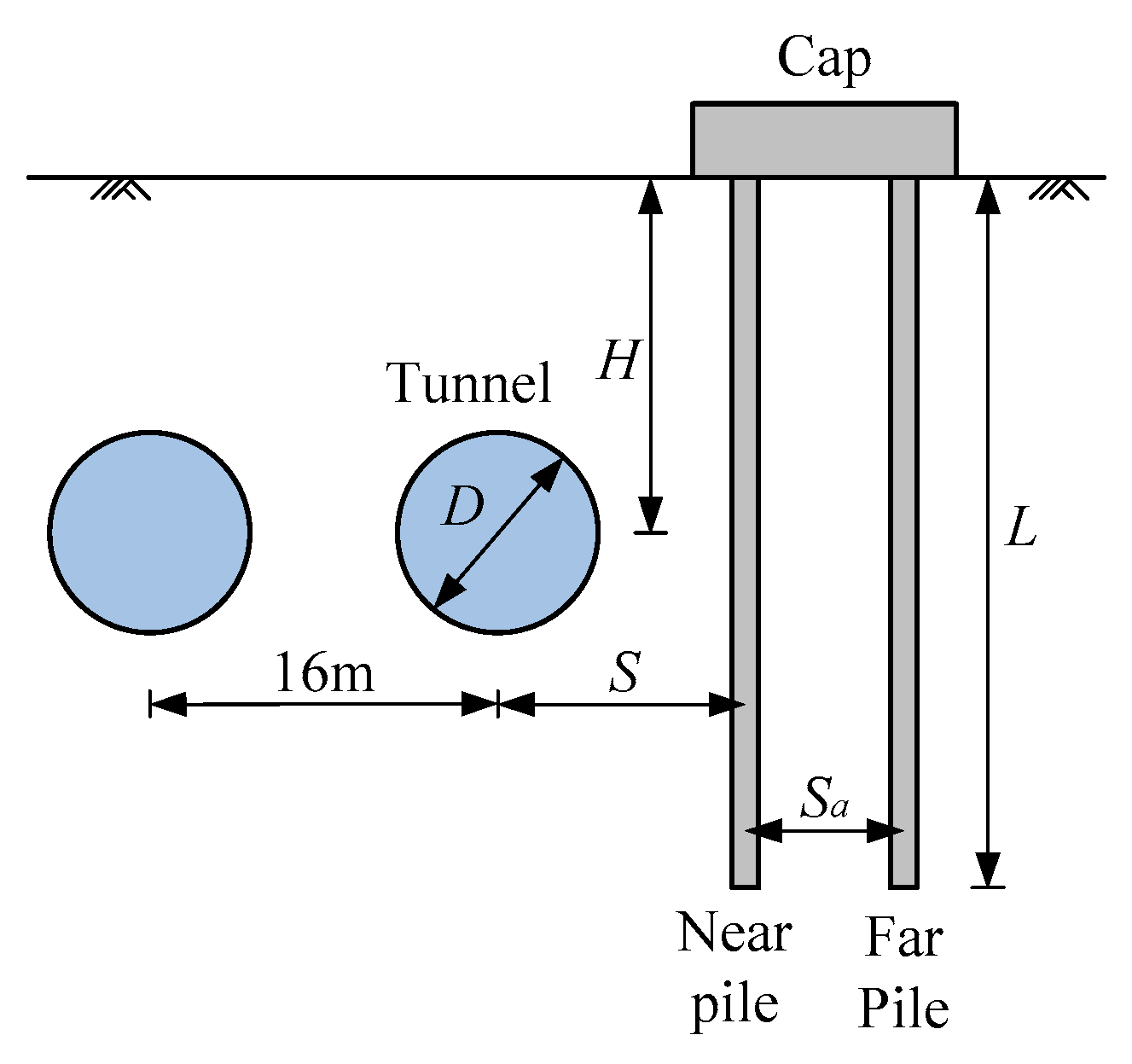
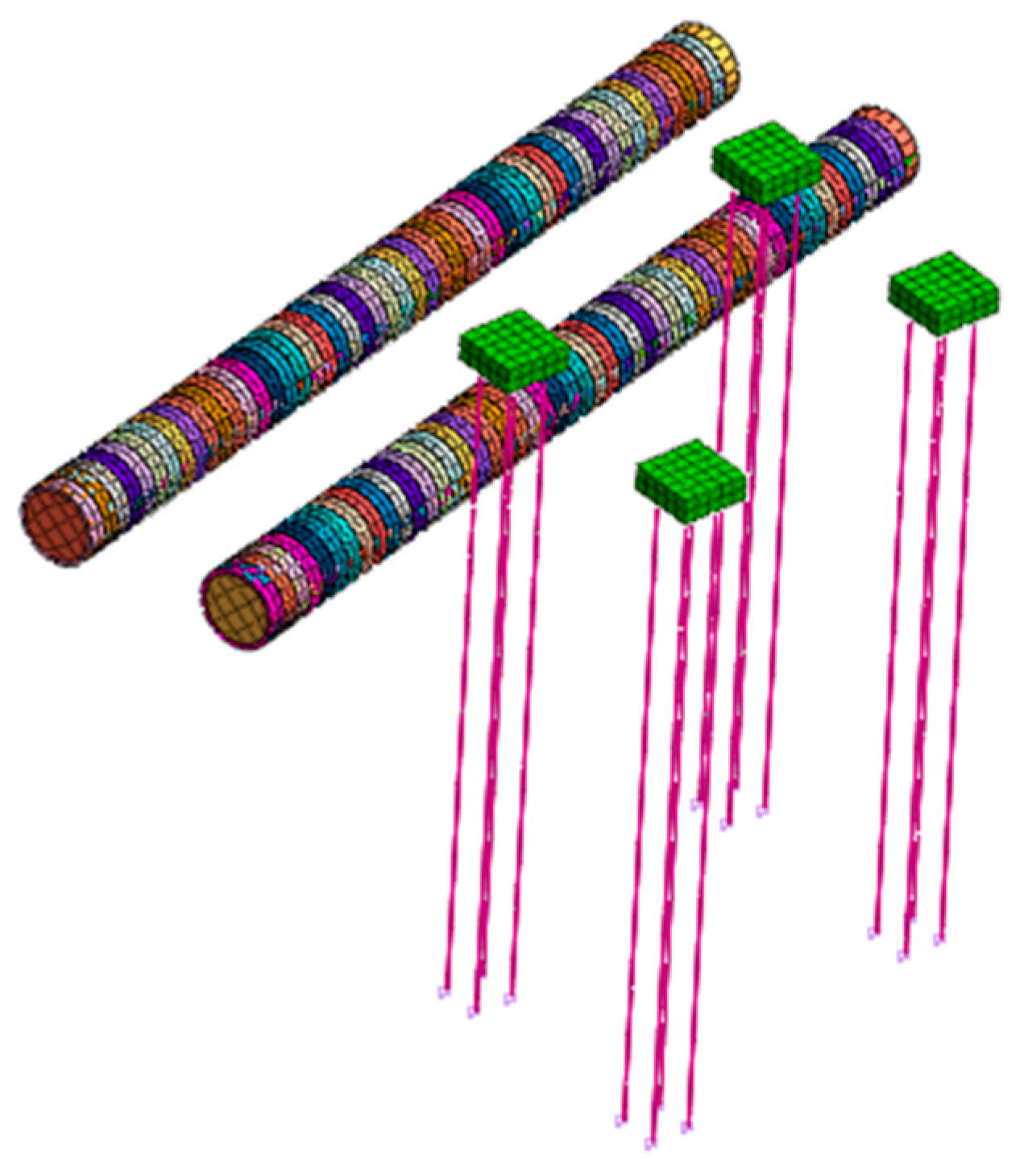
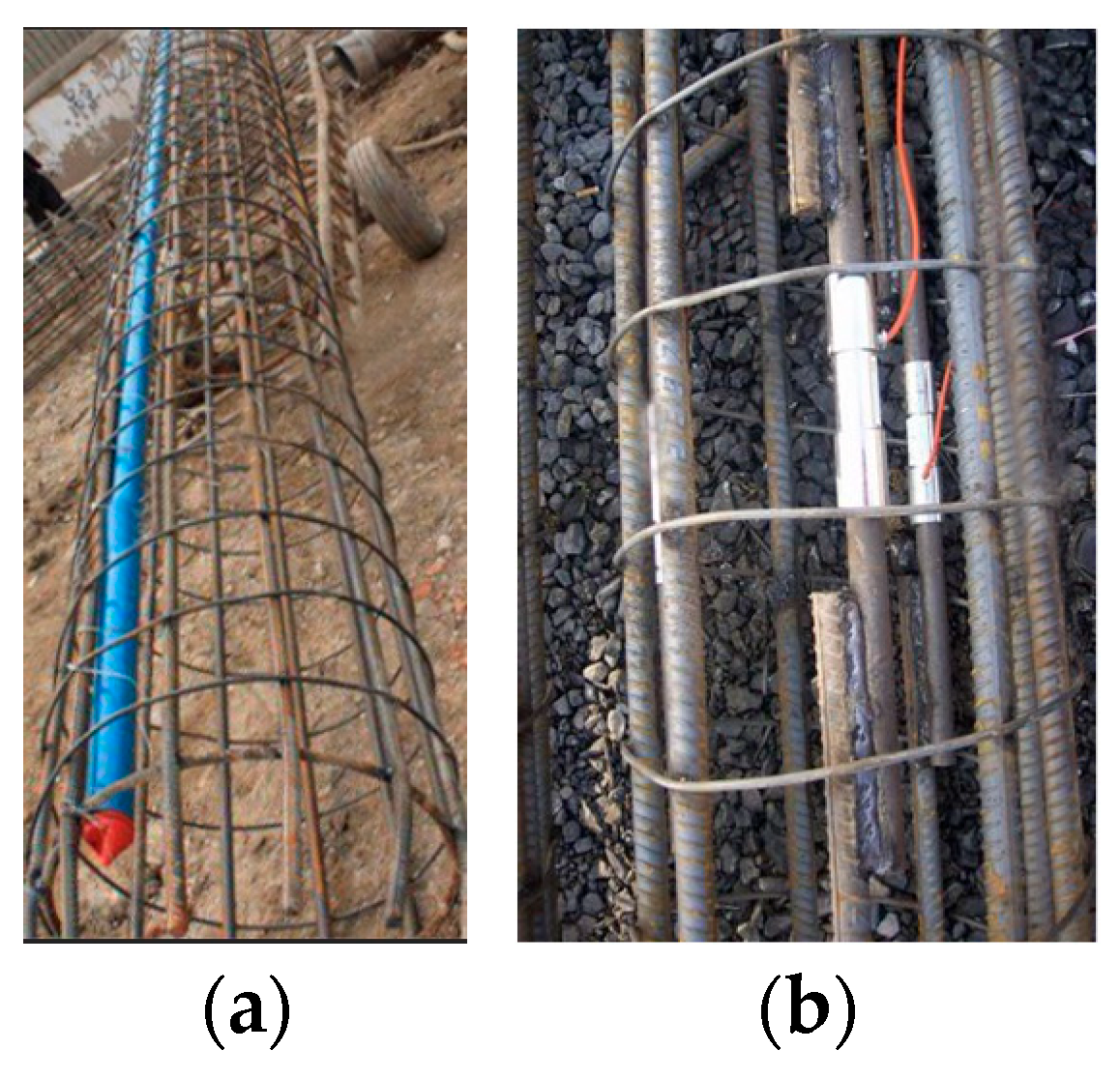
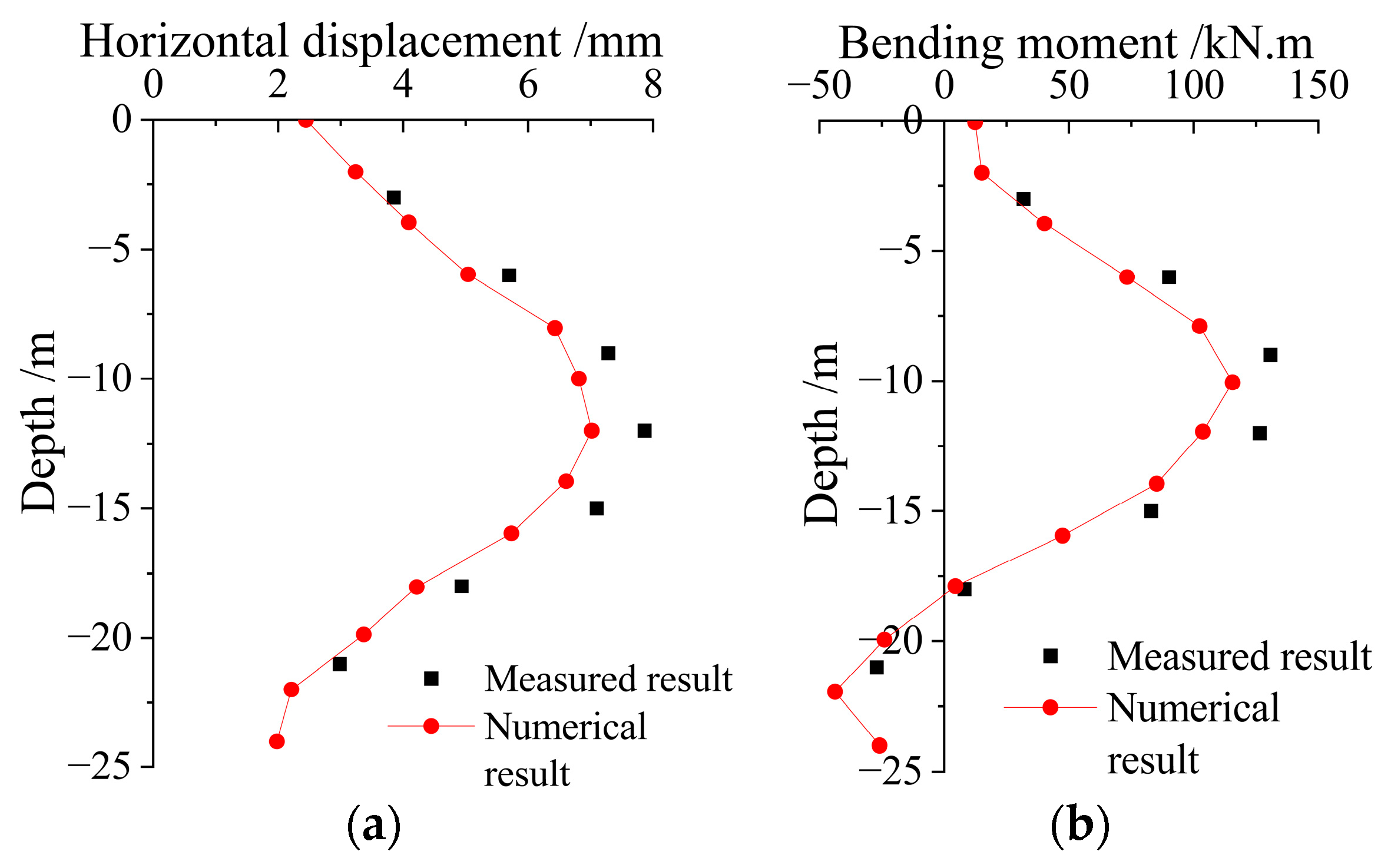
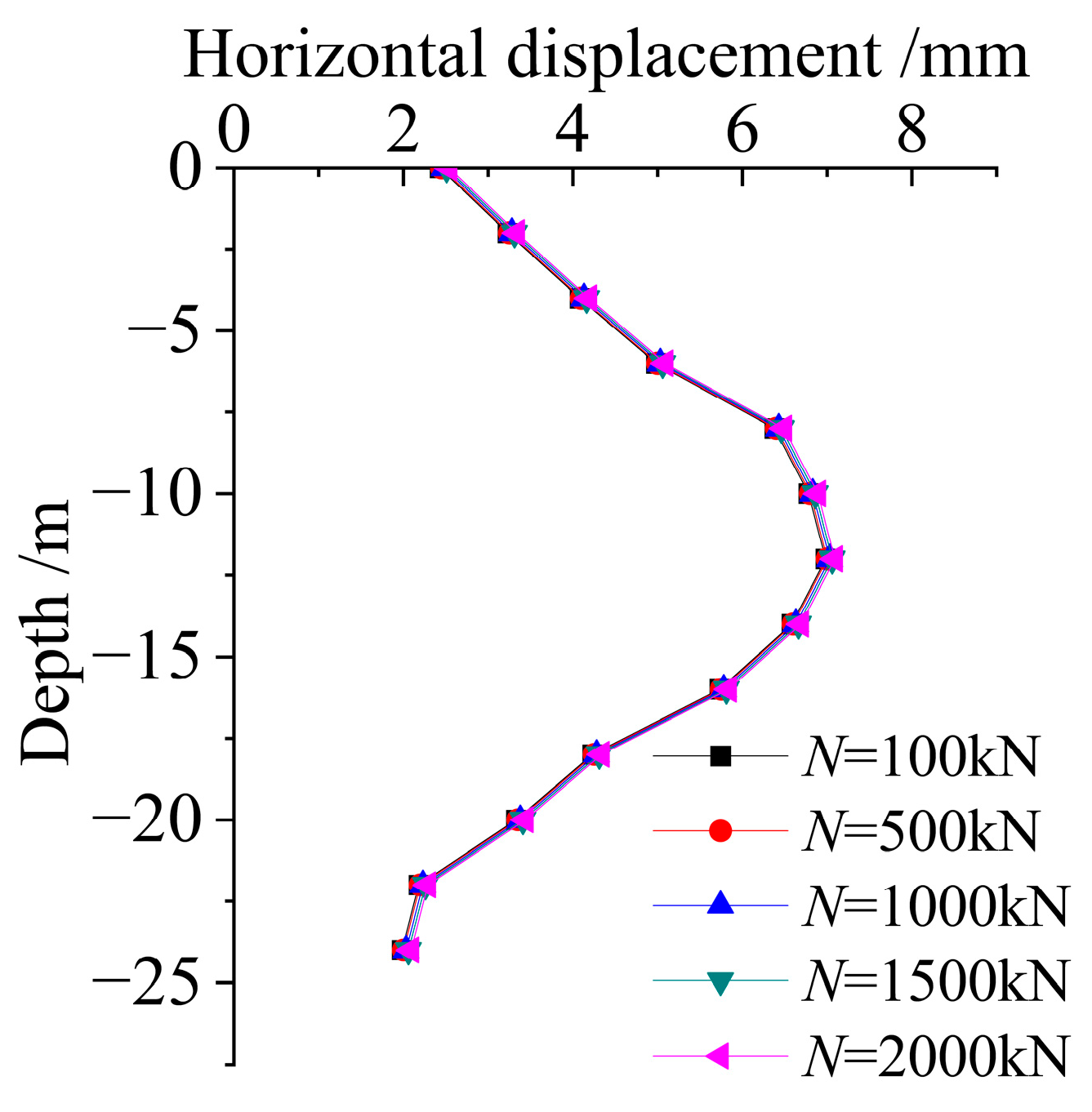
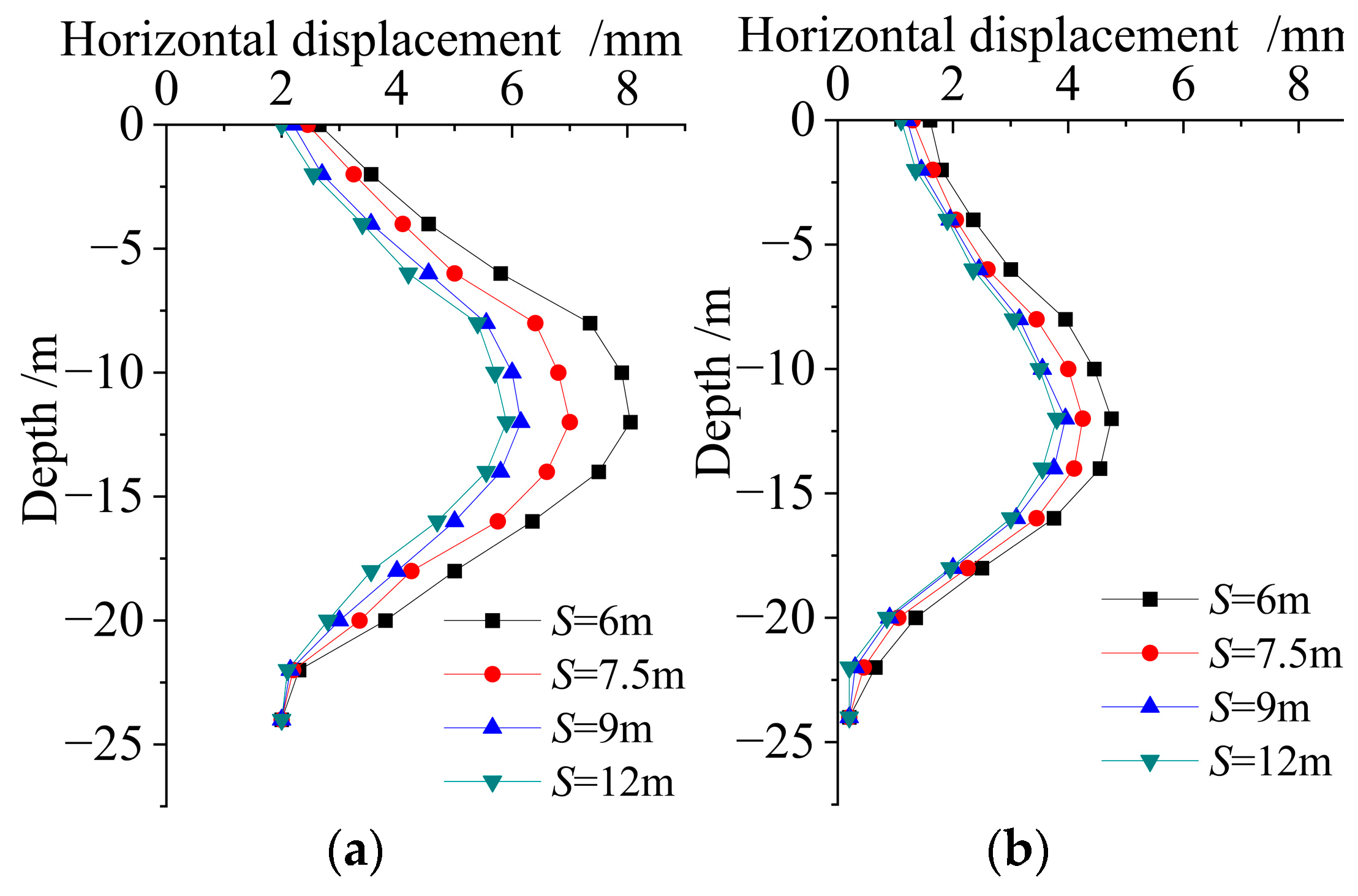
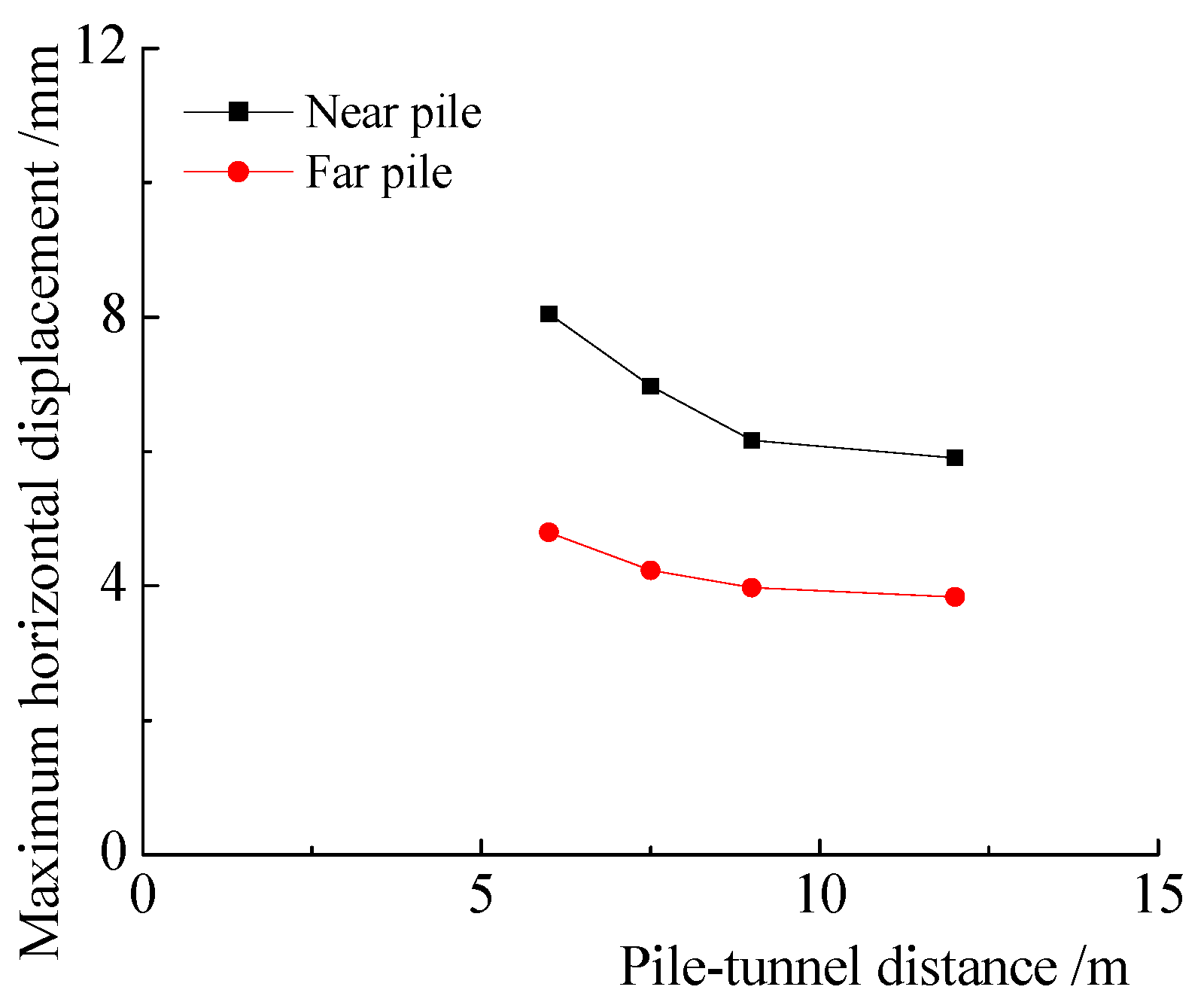

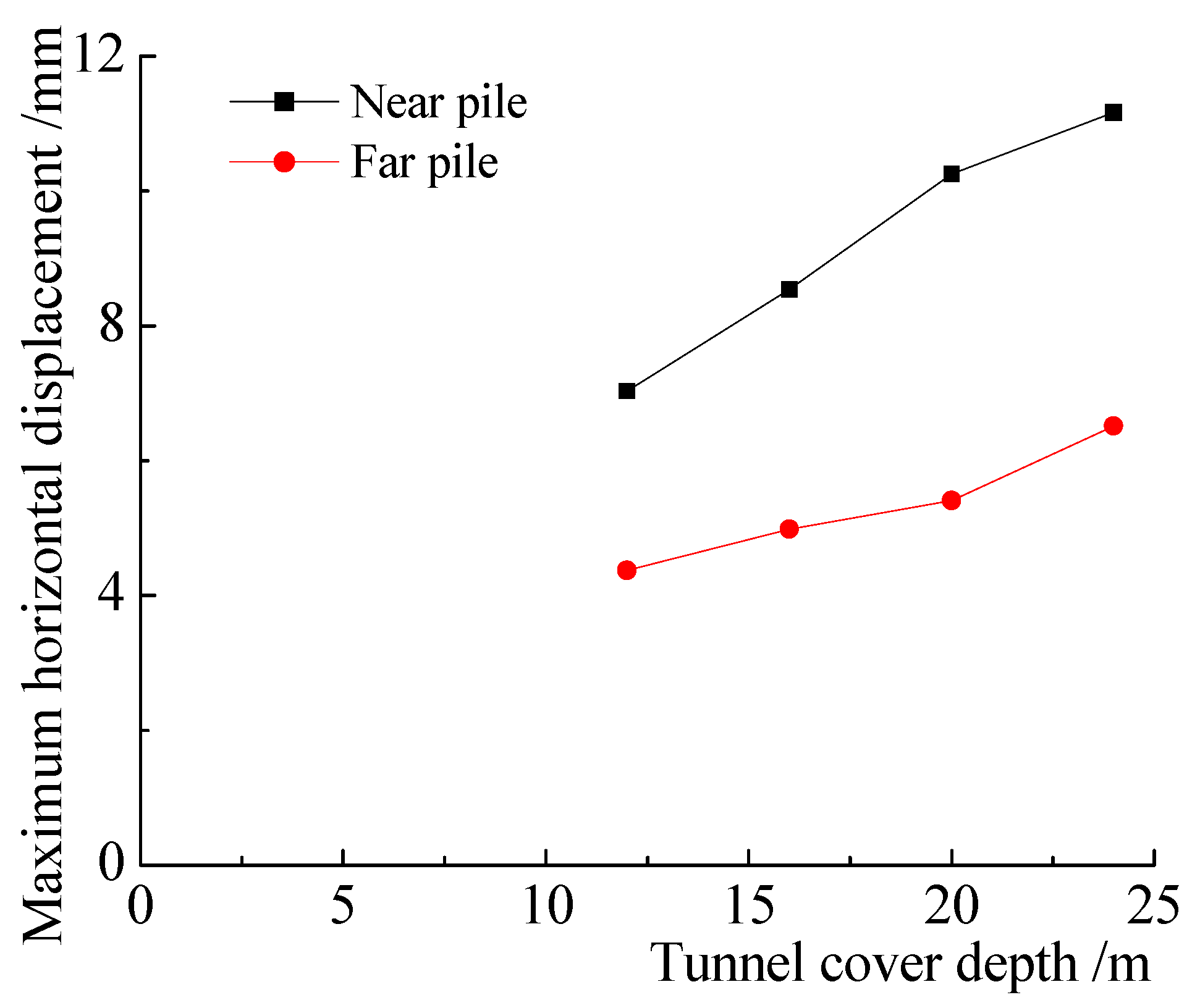
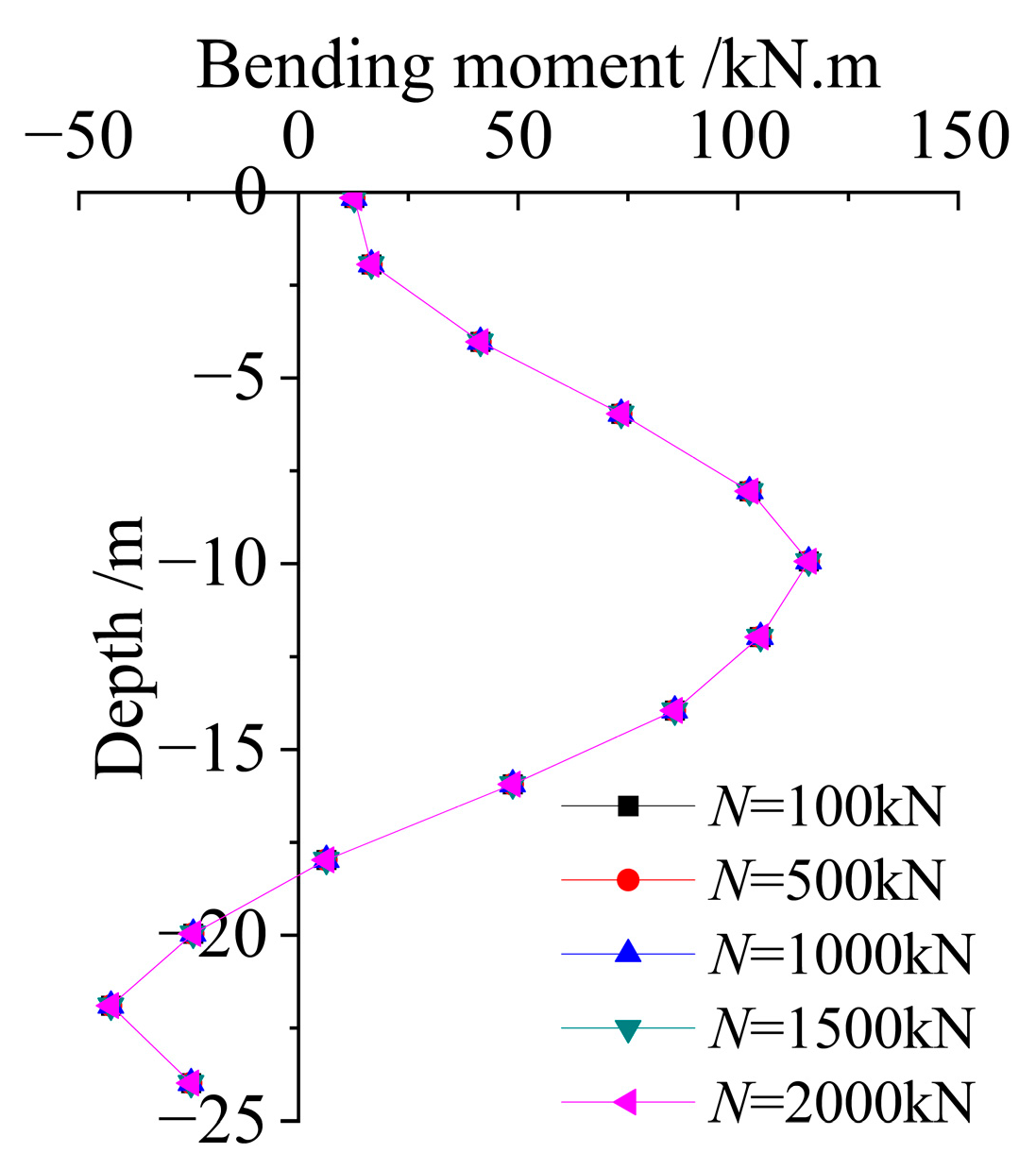
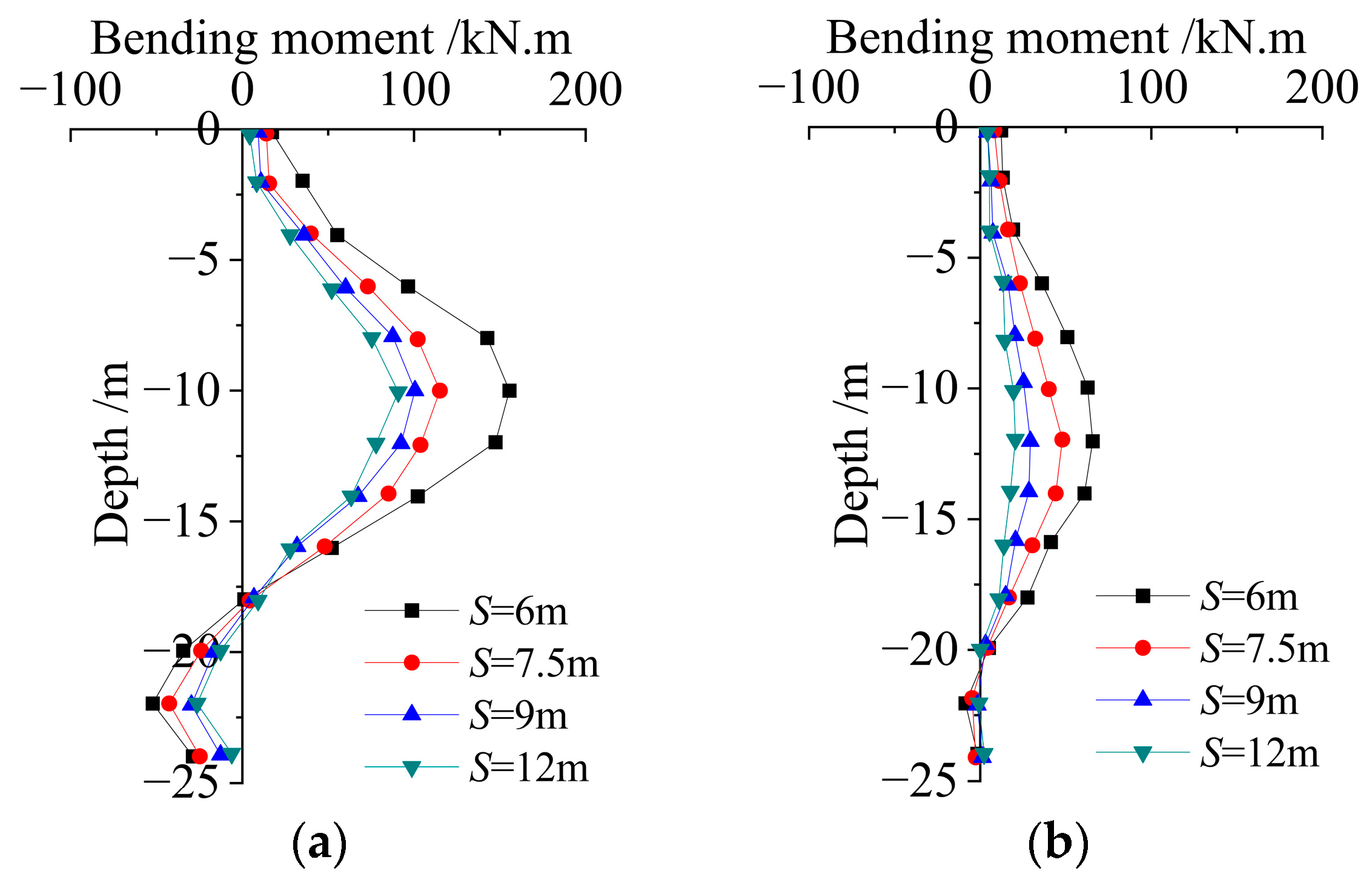

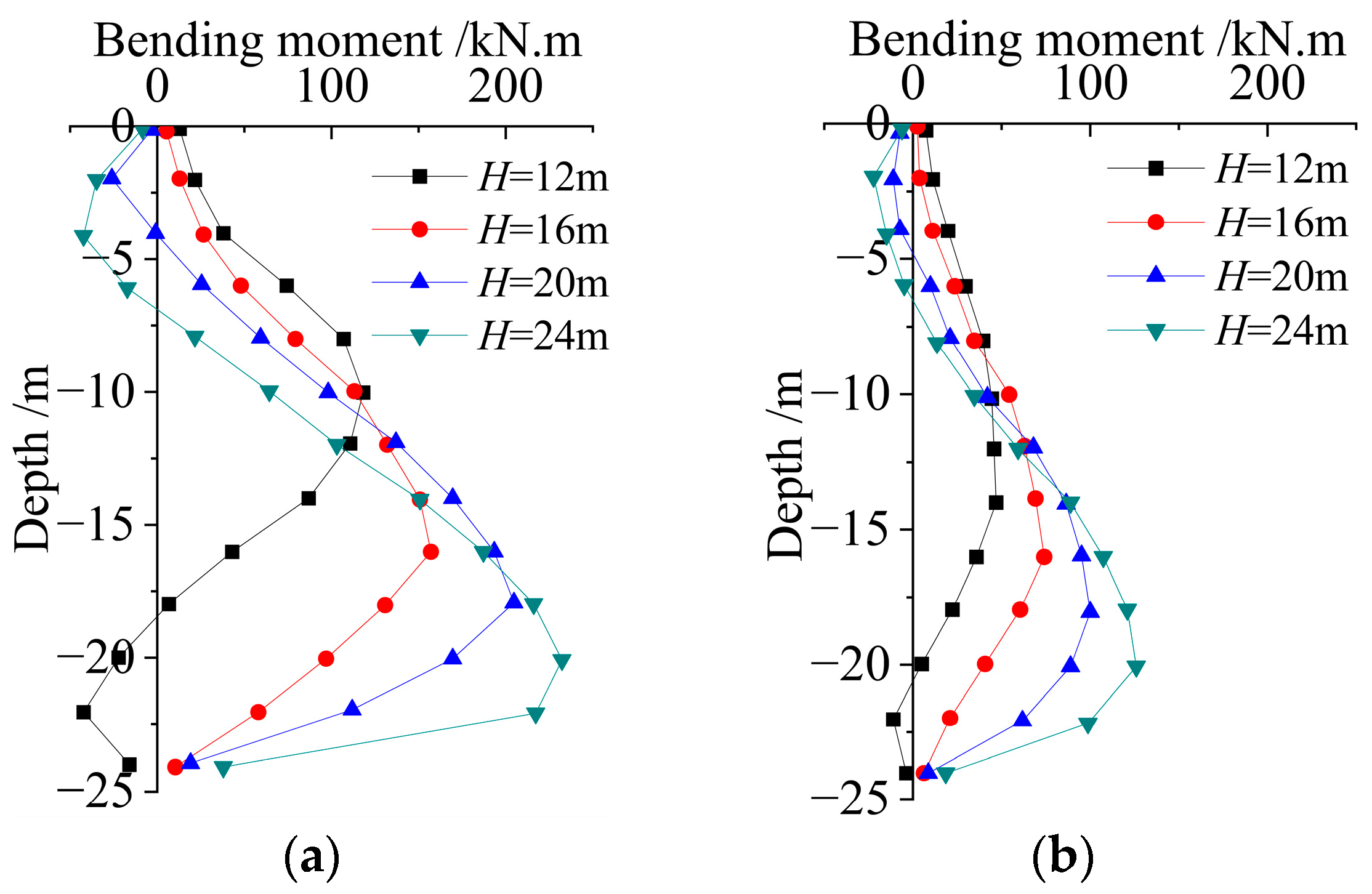
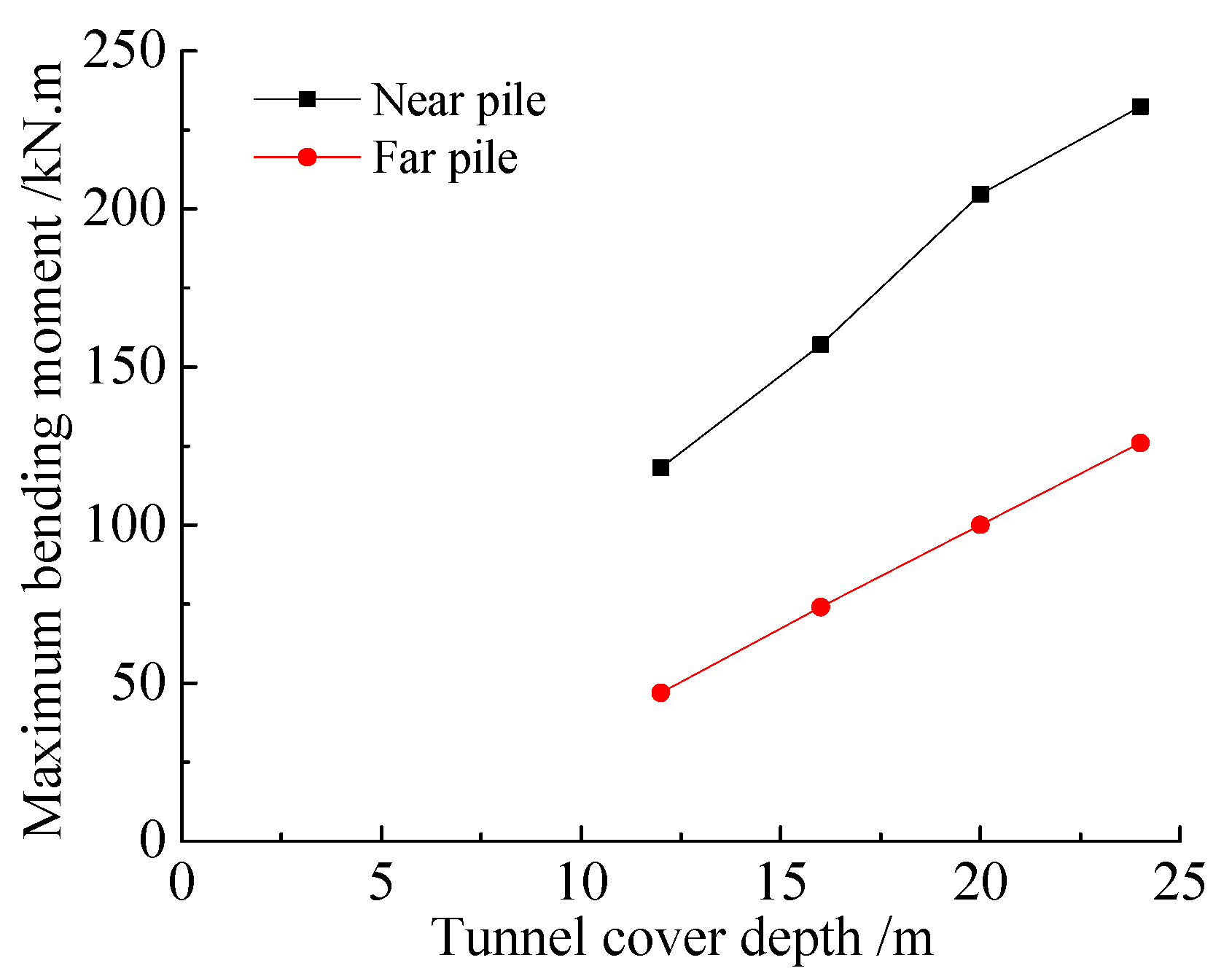
| Soil Type | Thickness of Soil /m | Unit Weight /kN∙m−3 | Elastic Modulus /MPa | Poisson’s Ratio | Cohesion /kPa | Internal Friction /° |
|---|---|---|---|---|---|---|
| Miscellaneous fill | 1.5 | 18.6 | 3.9 | 0.31 | 9 | 5 |
| Clayey silt | 36.5 | 19.2 | 7.2 | 0.27 | 15.5 | 22.7 |
| Silt | 20 | 19.6 | 14.3 | 0.25 | 3 | 26.2 |
| Fine sand | 27 | 19.9 | 18.8 | 0.23 | 0 | 28 |
Disclaimer/Publisher’s Note: The statements, opinions and data contained in all publications are solely those of the individual author(s) and contributor(s) and not of MDPI and/or the editor(s). MDPI and/or the editor(s) disclaim responsibility for any injury to people or property resulting from any ideas, methods, instructions or products referred to in the content. |
© 2023 by the authors. Licensee MDPI, Basel, Switzerland. This article is an open access article distributed under the terms and conditions of the Creative Commons Attribution (CC BY) license (https://creativecommons.org/licenses/by/4.0/).
Share and Cite
Zhang, S.; Zhang, X.; Ning, X.; Lu, H.; Jiang, M.; Wei, S.; Xiao, X. Effect of Shield-Tunnel Construction on the Horizontal Response of Adjacent Piles in a Silty Layer. Buildings 2023, 13, 2455. https://doi.org/10.3390/buildings13102455
Zhang S, Zhang X, Ning X, Lu H, Jiang M, Wei S, Xiao X. Effect of Shield-Tunnel Construction on the Horizontal Response of Adjacent Piles in a Silty Layer. Buildings. 2023; 13(10):2455. https://doi.org/10.3390/buildings13102455
Chicago/Turabian StyleZhang, Shuai, Xue Zhang, Xuan Ning, Haiyun Lu, Minmin Jiang, Shiguang Wei, and Xulian Xiao. 2023. "Effect of Shield-Tunnel Construction on the Horizontal Response of Adjacent Piles in a Silty Layer" Buildings 13, no. 10: 2455. https://doi.org/10.3390/buildings13102455
APA StyleZhang, S., Zhang, X., Ning, X., Lu, H., Jiang, M., Wei, S., & Xiao, X. (2023). Effect of Shield-Tunnel Construction on the Horizontal Response of Adjacent Piles in a Silty Layer. Buildings, 13(10), 2455. https://doi.org/10.3390/buildings13102455





